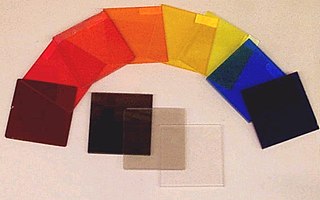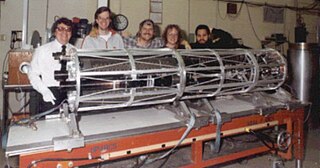
Diffraction is the interference or bending of waves around the corners of an obstacle or through an aperture into the region of geometrical shadow of the obstacle/aperture. The diffracting object or aperture effectively becomes a secondary source of the propagating wave. Italian scientist Francesco Maria Grimaldi coined the word diffraction and was the first to record accurate observations of the phenomenon in 1660.

An optical spectrometer is an instrument used to measure properties of light over a specific portion of the electromagnetic spectrum, typically used in spectroscopic analysis to identify materials. The variable measured is most often the irradiance of the light but could also, for instance, be the polarization state. The independent variable is usually the wavelength of the light or a unit directly proportional to the photon energy, such as reciprocal centimeters or electron volts, which has a reciprocal relationship to wavelength.

In physics and mathematics, wavelength or spatial period of a wave or periodic function is the distance over which the wave's shape repeats. In other words, it is the distance between consecutive corresponding points of the same phase on the wave, such as two adjacent crests, troughs, or zero crossings. Wavelength is a characteristic of both traveling waves and standing waves, as well as other spatial wave patterns. The inverse of the wavelength is called the spatial frequency. Wavelength is commonly designated by the Greek letter lambda (λ). The term "wavelength" is also sometimes applied to modulated waves, and to the sinusoidal envelopes of modulated waves or waves formed by interference of several sinusoids.

The W. M. Keck Observatory is an astronomical observatory with two telescopes at an elevation of 4,145 meters (13,600 ft) near the summit of Mauna Kea in the U.S. state of Hawaii. Both telescopes have 10 m (33 ft) aperture primary mirrors, and when completed in 1993 and 1996 were the largest astronomical telescopes in the world. They are currently the 3rd and 4th largest.

Angular resolution describes the ability of any image-forming device such as an optical or radio telescope, a microscope, a camera, or an eye, to distinguish small details of an object, thereby making it a major determinant of image resolution. It is used in optics applied to light waves, in antenna theory applied to radio waves, and in acoustics applied to sound waves. The colloquial use of the term "resolution" sometimes causes confusion; when an optical system is said to have a high resolution or high angular resolution, it means that the perceived distance, or actual angular distance, between resolved neighboring objects is small. The value that quantifies this property, θ, which is given by the Rayleigh criterion, is low for a system with a high resolution. The closely related term spatial resolution refers to the precision of a measurement with respect to space, which is directly connected to angular resolution in imaging instruments. The Rayleigh criterion shows that the minimum angular spread that can be resolved by an image forming system is limited by diffraction to the ratio of the wavelength of the waves to the aperture width. For this reason, high resolution imaging systems such as astronomical telescopes, long distance telephoto camera lenses and radio telescopes have large apertures.

The resolution of an optical imaging system – a microscope, telescope, or camera – can be limited by factors such as imperfections in the lenses or misalignment. However, there is a principal limit to the resolution of any optical system, due to the physics of diffraction. An optical system with resolution performance at the instrument's theoretical limit is said to be diffraction-limited.

Observational astronomy is a division of astronomy that is concerned with recording data about the observable universe, in contrast with theoretical astronomy, which is mainly concerned with calculating the measurable implications of physical models. It is the practice and study of observing celestial objects with the use of telescopes and other astronomical instruments.

A monochromator is an optical device that transmits a mechanically selectable narrow band of wavelengths of light or other radiation chosen from a wider range of wavelengths available at the input. The name is from the Greek roots mono-, "single", and chroma, "colour", and the Latin suffix -ator, denoting an agent.

An optical filter is a device that selectively transmits light of different wavelengths, usually implemented as a glass plane or plastic device in the optical path, which are either dyed in the bulk or have interference coatings. The optical properties of filters are completely described by their frequency response, which specifies how the magnitude and phase of each frequency component of an incoming signal is modified by the filter.

A spectrohelioscope is a type of solar telescope designed by George Ellery Hale in 1924 to allow the Sun to be viewed in a selected wavelength of light. The name comes from Latin- and Greek-based words: "Spectro," referring to the optical spectrum, "helio," referring to the Sun, and "scope," as in telescope.

The NASA Infrared Telescope Facility is a 3-meter (9.8 ft) telescope optimized for use in infrared astronomy and located at the Mauna Kea Observatory in Hawaii. It was first built to support the Voyager missions and is now the US national facility for infrared astronomy, providing continued support to planetary, solar neighborhood, and deep space applications. The IRTF is operated by the University of Hawaii under a cooperative agreement with NASA. According to the IRTF's time allocation rules, at least 50% of the observing time is devoted to planetary science.

A stepper is a device used in the manufacture of integrated circuits (ICs) that is similar in operation to a slide projector or a photographic enlarger. Stepper is short for step-and-repeat camera. Steppers are an essential part of the complex process, called photolithography, which creates millions of microscopic circuit elements on the surface of silicon wafers out of which chips are made. These chips form the heart of ICs such as computer processors, memory chips, and many other devices.

The Kodaikanal Solar Observatory is a solar observatory owned and operated by the Indian Institute of Astrophysics. It is on the southern tip of the Palani Hills 4 kilometres (2.5 mi) from Kodaikanal.

The Multi-spectral solar telescope array, or MSSTA, was a sounding rocket payload built by Professor A.B.C. Walker, Jr. at Stanford University in the 1990s to test EUV/XUV imaging of the Sun using normal incidence EUV-reflective multilayer optics. MSSTA contained a large number of individual telescopes, all trained on the Sun and all sensitive to slightly different wavelengths of ultraviolet light. Like all sounding rockets, MSSTA flew for approximately 14 minutes per mission, about 5 minutes of which were in space—just enough time to test a new technology or yield "first results" science. MSSTA is one of the last solar observing instruments to use photographic film rather than a digital camera system such as a CCD. MSSTA used film instead of a CCD in order to achieve the highest possible spatial resolution and to avoid the electronics difficulty presented by the large number of detectors that would have been required for its many telescopes.

The Apollo Telescope Mount, or ATM, was a crewed solar observatory that was a part of Skylab, the first American space station. It could observe the Sun in wavelengths ranging from soft X-rays, ultra-violet, and visible light.

Fourier-transform infrared spectroscopy (FTIR) is a technique used to obtain an infrared spectrum of absorption or emission of a solid, liquid, or gas. An FTIR spectrometer simultaneously collects high-resolution spectral data over a wide spectral range. This confers a significant advantage over a dispersive spectrometer, which measures intensity over a narrow range of wavelengths at a time.

OSO 7 or Orbiting Solar Observatory 7, before launch known as OSO H is the seventh in the series of American Orbiting Solar Observatory satellites launched by NASA between 1962 and 1975. OSO 7 was launched from Cape Kennedy on 29 September 1971 by a Delta N rocket into a 33.1° inclination, low-Earth orbit, and re-entered the Earth's atmosphere on 9 July 1974. It was built by the Ball Brothers Research Corporation (BBRC), now known as Ball Aerospace, in Boulder Colorado.

A spectrometer is a scientific instrument used to separate and measure spectral components of a physical phenomenon. Spectrometer is a broad term often used to describe instruments that measure a continuous variable of a phenomenon where the spectral components are somehow mixed. In visible light a spectrometer can separate white light and measure individual narrow bands of color, called a spectrum. A mass spectrometer measures the spectrum of the masses of the atoms or molecules present in a gas. The first spectrometers were used to split light into an array of separate colors. Spectrometers were developed in early studies of physics, astronomy, and chemistry. The capability of spectroscopy to determine chemical composition drove its advancement and continues to be one of its primary uses. Spectrometers are used in astronomy to analyze the chemical composition of stars and planets, and spectrometers gather data on the origin of the universe.

The Goode Solar Telescope (GST) is a scientific facility for studies of the Sun named after Philip R. Goode. It was the solar telescope with the world's largest aperture in operation for more than a decade. Located in Big Bear Lake; California, the Goode Solar Telescope is the main telescope of the Big Bear Solar Observatory operated by the New Jersey Institute of Technology (NJIT). Initially named New Solar Telescope (NST), first engineering light was obtained in December 2008, and scientific observations of the Sun began in January 2009. On July 17, 2017, the NST was renamed in honor of Goode, a former, and founding director of NJIT's Center for Solar-Terrestrial Research and the principal investigator of the facility. Goode conceived, raised the funds, and assembled the team that built and commissioned the telescope, and it was the highest resolution solar telescope in the world (until the end of 2019) and the first facility class solar telescope built in the U.S. in a generation.
Littrow expansion and its counterpart Littrow compression are optical effects associated with slitless imaging spectrographs. In a slitless imaging spectrograph, light is focused with a conventional optical system, which includes a transmission or reflection grating as in a conventional spectrograph. This disperses the light, according to wavelength, in one direction; but no slit is interposed into the beam. For pointlike objects this results in a spectrum on the focal plane of the instrument for each imaged object. For distributed objects with emission-line spectra, it results in an image of the object at each wavelength of interest, overlapping on the focal plane, as in a spectroheliograph.



















